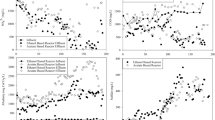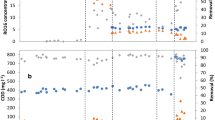Abstract
Combination of anaerobic–aerobic sequencing processes result in both anaerobic color removal and aerobic aromatic amine removal during the treatment of dye-containing wastewaters. The aim of the present study was to gain more insight into the competitive biochemical reactions between sulfate and azo dye in the presence of glucose as electron donor source. For this aim, anaerobic–aerobic sequencing batch reactor fed with a simulated textile effluent including Remazol Brilliant Violet 5R (RBV 5R) azo dye was operated with a total cycle time of 12 h including anaerobic (6 h) and aerobic cycles (6 h). Microorganism grown under anaerobic phase of the reactor was exposed to different amounts of competitive electron acceptor (sulfate). Performance of the anaerobic phase was determined by monitoring color removal efficiency, oxidation reduction potential, color removal rate, chemical oxygen demand (COD), color, specific anaerobic enzyme (azo reductase) and aerobic enzyme (catechol 1,2-dioxygenase), and formation of aromatic amines. The presence of sulfate was not found to significantly affect dye decolorization. Sulfate and azo dye reductions took place simultaneously in all operational conditions and increase in the sulfate concentration generally stimulated the reduction of RBV 5R. However, sulfate accumulation under anaerobic conditions was observed proportional to increasing sulfate concentration.







Similar content being viewed by others
References
Pandey A, Singh P, Iyengar L (2007) Bacterial decolorization and degradation of azo dyes. Int Biodeterior Biodegrad 59:73–84
Lourenço ND, Novais JM, Pinheiro HM (2001) Effect of some operational parameters on textile dye biodegradation in a sequential batch reactor. J Biotechnol 89:163–174
Shaw CB, Carliell CM, Wheatley AD (2002) Anaerobic/aerobic treatment of coloured textile effluents using sequencing batch reactors. Water Res 36(8):1993–2001
Carliell CM, Barclay SJ, Naidoo N (1995) Microbial decolourisation of a reactive azo dye under anaerobic conditions. Water SA 21:61–69
Gottlieb A, Shaw C, Smith A, Wheatley A, Forsythe S (2003) The toxicity of textile reactive azo dyes after hydrolysis and decolourisation. J Biotechnol 101:49–56
Haug W, Schmidt A, Nortemann B, Hempel DC, Stolz A, Knackmuss HJ (1991) Mineralization of the sulfonated azo dye mordant yellow 3 by a 6-aminophtalene-2-sulfonate-degrading bacterial consortium. Appl Environ Microbiol 57:3144–3149
Zaoyan Y, Ke S, Guangliang S, Fan Y, Jinshan D, Huanian M (1992) Anaerobic-aerobic treatment of a dye wastewater by combination of RBC with activated sludge. Water Sci Technol 26:2093–2096
Seshadri S, Bishop PL, Agha AM (1994) Anaerobic/aerobic treatment of selected azo dyes in wastewater. Waste Manage (Oxford) 14:127–137
Kudlich M, Bishop P, Knackmuss HJ, Stolz A (1996) Simultaneous anaerobic and aerobic degradation of the sulfonated azo dye Mordant Yellow 3 by immobilized cells from a naphthalenesulfonate-degrading mixed culture. Applied Microbiol Biotechnol 46:597–603
Hu TL (1998) Degradation of azo dye RP2B by Pseudomonas luteola. Water Sci Technol 38:299–306
Sen S, Demirer GN (2003) Anaerobic treatment of synthetic textile wastewater containing a reactive azo dye. J Environ Eng 129:595–601
O’Neill C, Lopez A, Esteves S, Hawkes FR, Hawkes DL, Wilcox S (2000) Azo-dye degradation in an anaerobic–aerobic treatment system operating on simulated textile effluent. Appl Microbiol Biotechnol 53(2):249–254
Dos Santos AB, Cervantes FJ, van Lier JB (2007) Review paper on current technologies for decolourisation of textile wastewaters perspectives for anaerobic biotechnology. Bioresour Technol 98:2369–2385
Luangdilok W, Paswad T (2000) Effect of chemical structures of reactive dyes on color removal by an anaerobic–aerobic process. Water Sci Technol 42(3–4):377–382
Panswad T, Iamsamer K, Anotai J (2001) Decolorisation of azo-reactive dye by polyphosphate and glycogen-accumulating organisms in an anaerobic–aerobic sequencing batch reactor. Bioresour Technol 76:151–159
Basibuyuk M, Forster CF (1997) ‘The use of sequential anaerobic/aerobic processes for the biotreatment of a simulated dyeing wastewater’. Environ Technol 18:843–848
Lourenço ND, Novais JM, Pinheiro HM (2000) Reactive textile dye colour removal in a sequencing batch reactor. Water Sci Technol 42:321–328
Panswad T, Luangdilok W (2000) Decolorization of reactive dyes with different molecular structures under different environmental conditions. Water Res 34(17):4177–4184
Çınar Ö, Demiröz K, Kanat G, Uysal Y, Yaman C (2009) The effect of oxygen on anaerobic color removal of azo dye in sequencing batch reactor. Clean 37(8):657–662
van der Zee FP, Bisschops IAE, Blanchard VG, Bouwman RHM, Lettinga G, Field JA (2003) The contribution of biotic and abiotic processes during azo dye reduction in anaerobic sludge. Water Res 37:3098–3109
Carliell CM, Barclay SJ, Shaw C, Wheatley AD, Buckley CA (1998) The effect of salts used in textile dyeing on microbial decolourisation of a reactive azo dye. Environ Technol 19:1133–1137
Albuquerque MGE, Lopes AT, Serralheiro ML (2005) Biological sulphate reduction and redox mediatör effects on azo dye decolourisation in anaerobic–aerobic sequencing batch reactors. Enzyme Microb Technol 36:790–799
Kim SY, An JY, Kim BW (2008) The effects of reductant and carbon source on the microbial decolorization of azo dyes in an anaerobic sludge process. Dyes Pigm 76:256–263
Yoo ES (2002) Kinetics of chemical decolorization of the azo dye C.I. Reactive Orange 96 by sulfide. Chemosphere 47:925–931
Clesceri LS, Greenberg AE, Eaton AD (1998) Standard Methods for the Examination of Water and Wastewater (20th Edition). American Public Health Association and Water Environment Federation, Washington DC
Çınar Ö, Yaşar S, Kertmen M (2008) Effect of cycle time on biodegradation of azo dye in sequencing batch reactor. Process Saf Environ Prot 86:455–460
Kolomytseva MP, Baskunov BP, Golovleva LA (2007) Intradiol pathway of para-cresol conversion by Rhodococcus Opacus 1CP. J Biotechnol 2:886–893
Russ R, Rau J, Stolz A (2000) The function of cytoplasmic flavin reductases in the reduction of azo dyes by bacteria. Appl Environ Microbiol 66(4):1429–1434
Daniels, L., Hanson, R.S., Philips, J.A., 1994. Chemical analysis in methods for general and molecular bacteriology. Gerhart P (ed) American Society For Microbiology, Washington DC, pp 512–554
Dolla A, Fournier M, Dermoun Z (2006) Oxygen defense in sulfate-reducing bacteria. J Biotechnol 12:87–100
Dubin P, Wright KL (1975) Reduction of azo food dyes in cultures of Proteus vulgaris. Xenobiotica 5(9):563–571
Yoo ES, Libra J, Adrian L (2001) Mechanism of decolorization of azo dyes in an anaerobic mixed culture. J Environ Eng 127:844–849
Ong SA, Toorisaka E, Hirata M, Hano T (2008) Granular activated carbon biofilm configured sequencing batch reactor treatment of C.I. acid orange 7. Dyes Pigm 76:142–146
Işık M, Sponza DT (2005) Substrate removal kinetics in an upflow anaerobic sludge blanket reactor decolorising simulated textile wastewater. Process Biochem 40:1189–1198
Kapdan IK, Alparslan S (2005) Application of anaerobic–aerobic sequential system to real textile wastewater for color and COD removal. Enzyme Microb Technol 36:273–279
Lourenço ND, Novais JM, Pinheiro HM (2003) Analysis of secondary metabolite fate during anaerobic–aerobic azo dye biodegradation in a sequential batch reactor. Environ Technol 24(6):679–686
Supaka N, Juntongjin K, Damronglerd S (2004) Microbial decolorization of reactive azo dyes in a sequential anaerobic-aerobic system. J Chem Eng 99:169–176
van der Zee FP, Lettinga G, Field JA (2001) Azo dye decolourisation by anaerobic granular sludge. Chemosphere 44:1169–1176
Cervantes FJ, Enriquez JE, Mendoza Hernandez MR, Flores E, Field JA (2006) The role of sulphate reduction on the reductive decolorization of the azo dye reactive orange 14. Water Sci Technol 54(2):171–177
Cervantes FJ, Enriquez Javier E, Petatán Eden Galindo et al (2007) Biogenic sulphide plays a major role on the riboflavin-mediated decolourisation of azo dyes under sulphate-reducing conditions. Chemosphere 68(6):1082–1089
Kim SY, An JY, Kim BW (2008) The effects of reductant and carbon source on the microbial decolorization of azo dyes in an anaerobic sludge process. Dyes Pigm 76:256–263
Lourenco ND, Novais JM, Pinheiro HM (2006) Kinetic studies of reactive azo dye decolorization in anaerobic/aerobic sequencing batch reactors. Biotechnol Lett 28:733–739
Ramalho A, Cardoso MH, Cavaco-Paulo A, Ramalho MT (2004) Characterization of azo reduction activity in a novel Ascomycete yeast strain. Appl Environ Microbiol 70:2279–2288
Author information
Authors and Affiliations
Corresponding author
Rights and permissions
About this article
Cite this article
Cirik, K., Kitis, M. & Cinar, O. The effect of biological sulfate reduction on anaerobic color removal in anaerobic–aerobic sequencing batch reactors. Bioprocess Biosyst Eng 36, 579–589 (2013). https://doi.org/10.1007/s00449-012-0813-2
Received:
Accepted:
Published:
Issue Date:
DOI: https://doi.org/10.1007/s00449-012-0813-2




